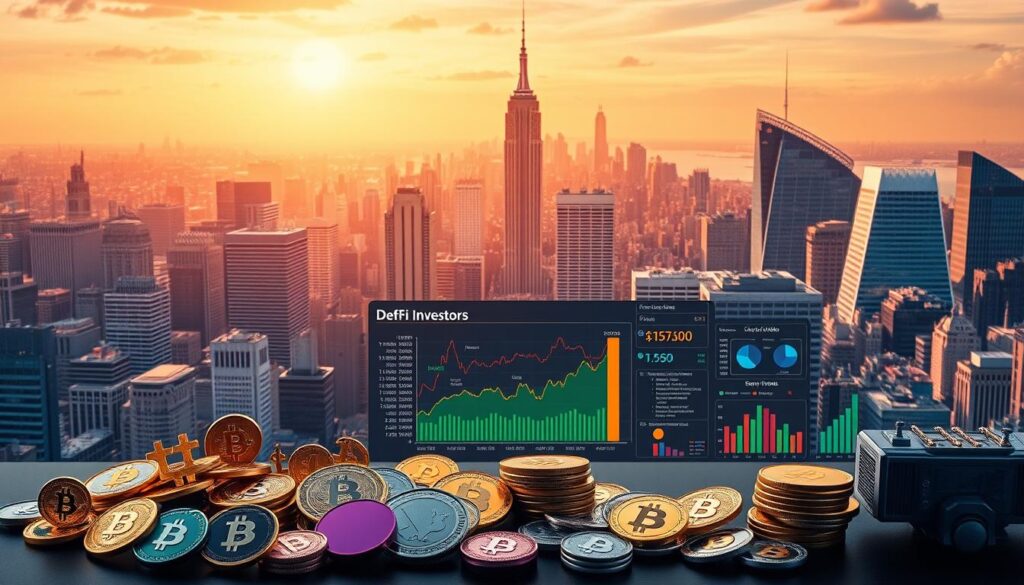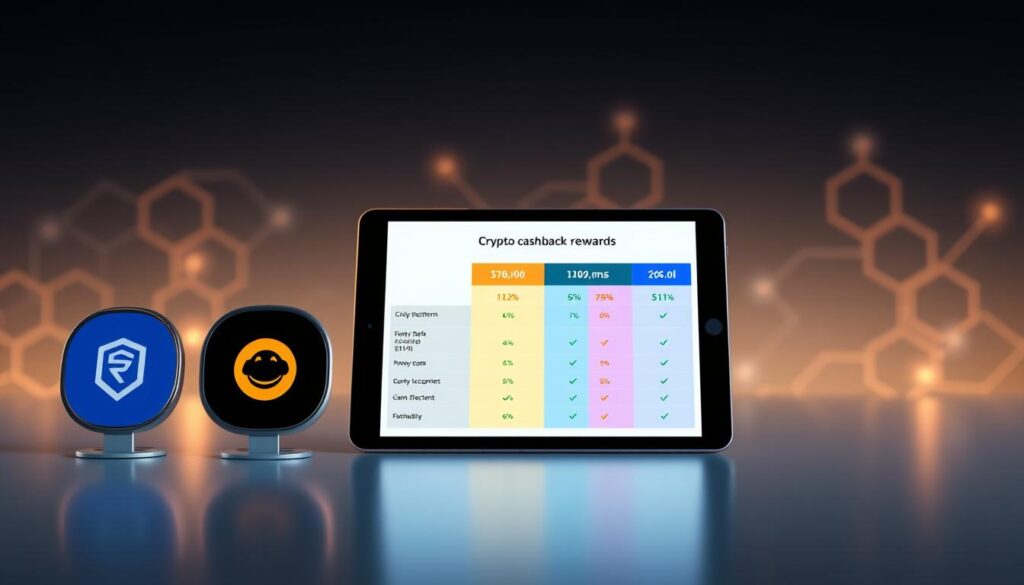Now Reading: The Ultimate DeFi Investment Guide for U.S. Investors
- 01
The Ultimate DeFi Investment Guide for U.S. Investors
The Ultimate DeFi Investment Guide for U.S. Investors

Decentralized Finance (DeFi) is changing the way we think about money. It offers U.S. investors new ways to lend, borrow, and make money. This guide helps you understand DeFi, from smart contracts to taxes, tailored for American investors.
This guide is clear and practical. It gives you the tools to dive into DeFi while following U.S. laws. It covers risks, tools, and strategies for the U.S. market.
Key Takeaways
- Explore the core principles of DeFi and its potential impact on traditional investment strategies.
- Learn how to navigate U.S. regulatory requirements affecting DeFi activities.
- Discover tools like crypto wallets and platforms compliant with U.S. financial standards.
- Understand tax implications and reporting obligations under IRS guidelines.
- Gain strategies to minimize risks like impermanent loss and smart contract vulnerabilities.
What is DeFi and Why Should U.S. Investors Pay Attention?
Decentralized finance, or DeFi, is changing how we think about money. It uses blockchain to cut out banks. For U.S. investors looking for new chances, knowing about DeFi is key. Investopedia says DeFi is a system where people can lend, trade, and save without banks.
The Evolution of Decentralized Finance
- 2009: Bitcoin introduced decentralized currency
- 2015: Ethereum smart contracts enabled programmable finance
- 2020: “DeFi Summer” saw $10B+ assets locked in platforms
- Today: Over 3,000 protocols operate across Ethereum, Solana, and other chains
Key Benefits of DeFi Over Traditional Systems
For U.S. investors, DeFi has a lot to offer:
- No bank fees for moving money across borders
- Instant transactions, unlike 3-day wire transfers
- 24/7 access to earn interest and join liquidity pools
- Clear protocols that anyone can check
Current Market Size and Growth Projections
DeFi’s total value locked (TVL) hit $82B in 2023. U.S. users made up 35% of this. Experts think DeFi will grow 30% each year until 2027. This growth is thanks to big investors and clearer rules.
These trends show DeFi’s big chance to become a major investment area. U.S. investors can join this exciting space. But, they must also think about managing risks.
The Legal Landscape of DeFi in the United States
Investing in DeFi in the U.S. requires understanding changing rules. Agencies like the SEC, CFTC, and FinCEN watch DeFi closely. They regulate smart contracts, tokens, and yield farming differently.
- SEC: Focuses on securities compliance, classifying some tokens as securities requiring registration.
- CFTC: Oversees crypto derivatives and decentralized exchanges.
- FinCEN: Enforces anti-money laundering (AML) rules for crypto transactions.
- IRS: Treats crypto as property, requiring tax reporting for all DeFi gains.
New York’s BitLicense sets extra rules for platforms there. Investors must check if platforms follow KYC/AML laws. Keeping up with regulatory changes helps avoid fines. Choose licensed platforms and clear protocols to follow U.S. laws.
For Americans, DeFi investing tips include avoiding unregistered tokens. Stay updated on local laws. This balance ensures safer DeFi market participation.
A Comprehensive Guide to DeFi Investments for U.S. Investors
Before diving into DeFi, U.S. investors must understand its core principles. This guide simplifies technical terms and infrastructure. It helps make better investment decisions.

Core DeFi Concepts Every American Investor Should Understand
Key terms include:
- Liquidity pools: Pooled funds for instant trades without traditional exchanges.
- AMMs (Automated Market Makers): Algorithms that set prices for tokens in platforms like Uniswap.
- governance tokens: Allow holders to vote on protocol changes, impacting investment outcomes.
The Blockchain Foundations of DeFi
Ethereum is the backbone, hosting 70% of DeFi apps. Layer 2 solutions like Polygon and Arbitrum reduce costs and speeds transactions. They are crucial for scalable U.S. investment strategies.
Smart Contracts and Their Role in DeFi
Self-executing code automates agreements, eliminating intermediaries. They enable transparent lending or staking. But, coding flaws can lead to vulnerabilities. Audited contracts like those on Compound or Aave reduce risks for investors.
Setting Up Your DeFi Investment Portfolio
Creating a DeFi portfolio needs careful planning. Start by picking secure tools and following U.S. rules. This guide will help you set up your assets safely and legally.
Essential Wallets for U.S.-Based DeFi Investors
Choosing the right wallet is key:
- MetaMask: Web-based hot wallet for Ethereum-based platforms
- Ledger/Trezor: Hardware wallets for cold storage of large holdings
- CelScan/Trust Wallet: Mobile options for easy access
Cold storage wallets keep your assets safe from online threats. Hot wallets are great for quick trades.
Acquiring and Managing Crypto Assets
Here’s how to buy assets legally:
- Buy crypto from U.S.-licensed exchanges like Coinbase or Binance.US
- Move funds to decentralized platforms using low-fee networks (Polygon, Avalanche)
- Use Layer 2 solutions to cut down on gas costs during transfers
Security Best Practices
Keep your assets safe with these tips:
- Never share private keys or seed phrases
- Enable 2FA on all accounts
- Check smart contract addresses before transactions
- Regularly check your portfolio activity
These steps are crucial for safe decentralized finance investment strategies. They help keep your assets safe in the U.S. markets.
Top DeFi Investment Platforms Accessible to American Investors
Choosing the right DeFi investment platforms in the U.S. means looking at usability, security, and if they follow local laws. U.S. investors should pick platforms that are safe and follow the rules. They should also offer good returns.
- Aave: Offers flexible borrowing/lending with algorithmic interest rates. Supports multiple crypto assets and integrates with major wallets.
- Compound: A pioneer in yield farming with transparent APY metrics. Users stake assets to earn rewards, though gas fees vary by network activity.
- Uniswap: A decentralized exchange enabling token swaps and liquidity provision. Low barriers to entry but requires understanding impermanent loss risks.
- Yearn Finance: Automates yield optimization across protocols. Focuses on maximizing returns through smart contract automation.
Platforms like Synthetix offer exposure to synthetic assets but demand advanced knowledge. Some platforms restrict U.S. users via geofencing; alternatives like PancakeSwap (BSC-based) may fill gaps but require cross-chain bridges. Always verify regulatory status via official websites to avoid compliance issues. Prioritize platforms with audited smart contracts and community trust metrics. Research fees, liquidity depth, and withdrawal options before committing funds to ensure alignment with personal risk tolerance.
DeFi Yield Farming Strategies for Maximizing Returns
To get the most out of top DeFi investment opportunities, you need smart yield farming plans. These plans include using liquidity pools, staking, and optimizing your efforts. They help U.S. investors grow their assets while keeping risks in check.

Supplying assets to automated market makers (AMMs) like Uniswap or SushiSwap is a key part of liquidity provision. You earn fees from trades and get protocol tokens. But, you must watch out for impermanent loss risks. Here are some important steps:
- Choose high-liquidity pools with stablecoins or major tokens
- Calculate net returns after subtracting fees and loss potential
- Track pool activity using platforms like Dune Analytics
Staking offers more than just traditional options. U.S. investors can try:
- Protocol-specific staking (e.g., Aave’s aTokens)
- Liquid staking derivatives for Ethereum-based assets
- Validator node participation where compliant with SEC guidelines
For advanced yield optimization, you need to stay active. You can use:
- Auto-compounding tools like Yearn Finance’s vaults
- Leveraged positions via platforms like Cream Finance
- Participating in early-stage protocol launches for airdrop eligibility
U.S. investors must keep track of taxes at every step. Token swaps, staking rewards, and liquidity provision all trigger taxes. Use tools like Nomics or Koinly to record gains and losses as the IRS requires. By balancing these strategies with your risk tolerance, you can find the best top DeFi investment opportunities today.
Navigating DeFi Lending and Borrowing Markets
In the comprehensive guide to DeFi investments for U.S. investors, learning about decentralized lending and borrowing is crucial. These markets allow users to lend crypto and earn interest or borrow assets by using their holdings as collateral. Platforms like Aave, Compound, and MakerDAO operate without traditional banks, offering clear rates and quick access.
Lending strategies aim to maximize returns. Users put their assets into pools to earn variable rates based on demand. Borrowers must post collateral worth more than their loan—often 150%—to avoid being liquidated. For instance, borrowing ETH with overcollateralized BTC reduces risks but requires watching price changes.
- Interest Rate Mechanics: Algorithms set rates dynamically; higher demand boosts returns for lenders.
- Collateralization Requirements: Protocols enforce strict ratios to prevent defaults.
- Flash Loans: Unsecured, instant loans require repayment in a single blockchain transaction—ideal for arbitrage but risky for novices.
U.S. regulators closely watch DeFi activities. The SEC considers some tokens as securities, so investors must check if platforms comply. Guides like the beginner’s guide to DeFi platforms help understand legal limits. Spreading investments across platforms lowers risk from any single protocol.
For the comprehensive guide to DeFi investments for U.S. investors, knowing these tools helps users balance rewards and risks in decentralized credit markets.
Understanding DeFi Risk Factors in the American Market
DeFi has changed the financial scene, but understanding DeFi for U.S. investors means knowing its risks. These risks include technical problems and changes in laws that could affect your money.
Smart Contract Vulnerabilities
Smart contracts make DeFi work, but bugs in them can cause hacks. Companies like Chainlink or OpenZeppelin check for these issues. It’s smart to look at security reports before investing.
Impermanent Loss Explained
Putting money into pools can lead to impermanent loss. For instance, putting $500 in ETH/USDT might lose value if prices change. Tools like DeFi yield tools help predict these losses, helping you make better choices.
Regulatory and Compliance Risks
The SEC in the U.S. is watching DeFi for any law breaking. Not following rules, like with unregistered tokens, can lead to fines. It’s important to stay updated on IRS tax rules to avoid legal trouble.
Tax Implications of DeFi Investments for U.S. Citizens

U.S. investors in DeFi face complex tax rules to avoid penalties. The IRS views crypto as property, so every transaction has tax effects. Here’s how to follow the rules.
IRS Guidance on Cryptocurrency and DeFi
- Staking rewards and providing liquidity trigger taxes. Gains are based on fair market value at the time.
- Airdrops and governance tokens are income when received. The IRS Notice 2014-21 and 2023 updates explain how to report.
Record-Keeping Requirements for DeFi Transactions
Keep detailed records of every transaction. Include dates, values, and wallet addresses. Use tools like CoinTracker or Koinly for Form 8949. If records are missing, blockchain explorers like Etherscan can help.
Working with Crypto-Savvy Tax Professionals
- Look for advisors with DeFi experience, like yield farming.
- Make sure they use IRS-compliant software for capital gains.
- Get advice before the year ends to avoid missed deductions.
Ignoring these steps can lead to audits. Always include tax planning in your DeFi strategy.
Analyzing DeFi Tokens: What Makes a Worthwhile Investment
For U.S. investors, DeFi token analysis needs a clear plan. First, look at tokenomics—the supply, use, and how it’s shared. Tokens with a small supply and clear use in the protocol are more valuable. For example, tokens for governance or staking in platforms like Compound or Uniswap are useful.
- Look at how the protocol makes money. Projects like Aave, which earns from liquidity pools or borrowing interest, have steady income.
- Check if the token can vote on changes. Tokens like MakerDAO’s MKR, which can vote on updates, might increase in value.
- Research the team behind the token. Clear teams with blockchain experience are safer. Stay away from unknown founders.
Watch metrics like total value locked (TVL) and user growth. High TVL means people trust the platform. But, compare it with the protocol’s income to spot fake numbers. Also, see how the treasury is managed. A well-funded treasury can support development and rewards.
U.S. investors should focus on regulatory compliance. Stay away from tokens that look like securities without the right permits. Use the SEC’s Howey Test to see if a token might be seen as a security.
DeFi token analysis also means testing how the token performs under stress. Try out scenarios where the market drops and check if the protocol has safety measures. Dune Analytics offers real-time data to track these aspects.
DeFi Insurance and Protection Mechanisms
Managing risks in decentralized finance requires proactive steps. U.S. investors need to focus on decentralized finance investment strategies that protect their assets. This section will cover tools and practices to lower exposure to common threats.
Coverage Options for Smart Contract Failures
Platforms like Nexus Mutual offer protection against smart contract vulnerabilities. They assess risks and provide payouts for bugs or hacks. Investors look at premiums, coverage limits, and claim approval rates when choosing.
For example, Etherisc’s flight delay insurance models also apply to DeFi smart contract failures. They offer structured compensation frameworks.
Protocol Insurance Funds
Some protocols have internal funds to stabilize operations. MakerDAO’s Safety Module, for instance, has reserves for black swan events. dYdX also allocates capital to reimburse users during critical failures.
Investors should check fund sizes and historical payouts to see if a protocol is reliable during market stress.
Best Practices for Risk Mitigation
- Spread funds across multiple protocols to avoid single points of failure.
- Test transactions on testnets before transferring large sums.
- Use hardware wallets to secure private keys offline.
- Regularly audit protocol documentation and third-party reviews.
By combining these steps with insurance options, defenses are strengthened. While no system is foolproof, these measures align with decentralized finance investment strategies that focus on long-term resilience.
Governance Participation: Adding Value While Earning Returns
U.S. investors can shape DeFi protocols and earn more by being active. DeFi investing tips often miss this crucial step. MakerDAO and Uniswap let users vote on upgrades and fees with governance tokens.
To participate, you need to hold tokens, research proposals, and vote via wallet interfaces. Many platforms support delegation, making it easier for small holders to join. This way, even those with little capital can make a difference.
- Financial incentives: Voting can earn you more tokens or airdrops.
- Risk mitigation: Active governance helps spot problems before they become big issues.
- Alignment: Users ensure protocols meet their needs, not just external goals.
Success stories like Aave’s interest rate changes show the power of collective decisions. But, Terra’s UST issues show the dangers of hasty decisions. U.S. investors need to watch for regulatory changes, as they could change how governance works.
For newbies, platforms like Snapshot make voting easy without moving tokens. Getting involved in governance is a smart move. It turns passive investments into powerful tools for growth and safety.
Comparing DeFi and Traditional Finance: The American Investor’s Perspective
U.S. investors looking at top DeFi investment opportunities need to know the differences. This analysis shows how DeFi compares in cost, access, and returns.
Cost Efficiency Analysis
Traditional banking charges for transfers, overdrafts, and keeping accounts. DeFi, on the other hand, cuts out middlemen, saving money. A 2022 Deloitte report found DeFi’s $130B+ ecosystem has lower costs. Yet, gas fees and network issues can affect it.
Accessibility and Inclusion Factors
- DeFi lets anyone join with just internet access, no credit checks needed.
- Traditional banking leaves out millions without bank accounts. DeFi, however, has its own barriers like learning about crypto.
Yield Comparison Across Investment Classes
DeFi often gives better returns than traditional savings. For example:
- DeFi’s liquidity pools offer 5–20% APY, while savings accounts give 0.01–2%.
- Stock dividends are 2–4%, but DeFi’s ups and downs need careful planning.
Those looking for top DeFi investment opportunities must consider these points. DeFi’s flexibility can work alongside traditional assets, helping to diversify portfolios.
Emerging DeFi Trends American Investors Should Monitor
U.S. investors looking into DeFi investment platforms in the U.S. need to keep up with new trends. Real-world asset tokenization is becoming more popular. It lets people invest in real estate, stocks, or commodities using blockchain.
Platforms are now making sure these investments follow U.S. rules. This makes it safe for DeFi protocols to work with these assets. Another important trend is cross-chain interoperability. This means using different blockchains together to offer more investment choices and lower risks.
Institutional adoption is also on the rise. Big firms are starting DeFi products that follow the rules. This includes stablecoins that earn interest or tokenized ETFs. Central bank digital currencies (CBDCs) could also change DeFi. A U.S. digital dollar might make payments easier but could also bring new rules for DeFi investment platforms in the U.S..
Investors should keep an eye on:
- Decentralized autonomous organizations (DAOs) expanding governance roles
- Layer-2 scaling solutions lowering transaction costs
- Compliance-focused platforms integrating anti-money laundering (AML) checks
Keeping up with these changes helps U.S. investors make the most of their investments. It’s important to watch how DeFi investment platforms in the U.S. adapt to these trends. This ensures they meet the changing market needs and rules.
Your Roadmap to DeFi Success in the American Financial Landscape
Starting a DeFi strategy means matching it to your experience level. Beginners should look at DeFi token analysis to find safe spots like stablecoin pools. Use platforms that are clear about U.S. rules to avoid legal issues.
For those in the middle, try yield farming but watch out for risks. Join American DeFi groups on CoinDesk or ConsenSys to keep up with news. Always check DeFi token analysis for U.S. investors to see if a project is well-run.
Experts should mix DeFi into their overall financial plans, using a small part of their money for it. Keep up with IRS tax rules and use crypto tax software for easy tracking. Stay updated on laws with SEC alerts and firms like Chainalysis.
Learning never stops. Watch SEC news and go to DeFi summits in the U.S. to learn more. Choose platforms that are open about their audits and have insurance for smart contract problems. This way, you can grow with DeFi in the U.S. while staying safe.
FAQ
What is DeFi and why is it important for U.S. investors?
Decentralized Finance, or DeFi, is a new way to handle money without banks. It lets people easily get into financial services. For U.S. investors, DeFi is key because it offers easy access, better returns, and new ways to invest.
Which DeFi platforms are suitable for American investors?
American investors can use Aave, Uniswap, Compound, and Yearn Finance. These platforms are safe and follow U.S. rules. They make it easy for Americans to start investing in DeFi.
What are the primary risks associated with DeFi investments for U.S. investors?
DeFi investments come with risks like bugs in smart contracts and losing money in pools. There’s also the risk of not following U.S. laws. Knowing these risks and how to avoid them is key to keeping investments safe.
How can U.S. investors maximize their DeFi returns?
To get the most from DeFi, U.S. investors can try yield farming and staking. These methods can earn a lot of money. But, it’s important to remember the risks and how volatile DeFi can be.
Are there tax obligations for U.S. investors involved in DeFi?
Yes, U.S. investors must follow IRS rules on DeFi and crypto. They need to keep track of their transactions and understand how different DeFi actions are taxed. Working with a tax expert who knows crypto is a good idea.
What are some essential security practices for U.S. DeFi investors?
U.S. DeFi investors should use hardware wallets, strong passwords, and two-factor authentication. Learning about phishing and checking transactions is also important to keep investments safe.
How do I analyze DeFi tokens for investment suitability?
When looking at DeFi tokens, U.S. investors should check tokenomics, governance, past performance, and revenue models. Doing deep research on these points helps make smart investment choices in DeFi.
What role does governance play in DeFi investments?
Governance in DeFi lets investors help shape the protocol. This can impact their investments. By getting involved, U.S. investors can earn returns and help ensure the protocol meets their needs and the community’s.













